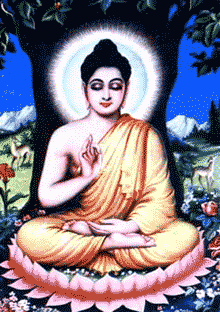Balagokulam Guide
Festivals
Biographies
Hindu Dharma
Other Topics
Sangh Prarthana
Ekata Mantra
Shlokas
Bhajans
Sangh Geet
Skits
|
|
Buddha Jayanti
 Siddartha (Gautama) was born in the sixth century BC in the country
Nepal. In those days, Nepal was a part of Bharat (India). Siddartha’s father,
Suddhodana, was the ruler of the Sakya people, and Siddartha grew up living
the extravagant life of a young prince. But, looking at the behavior of his son,
Suddhodana felt that his son (the prince) might leave the palace to take up the
life of a religious wanderer. So he arranged for him to be sheltered from all the
harsh realities of life. When the prince reached the age of sixteen, Suddhodana
arranged for him to be married to his cousin, a charming princess named Yashodhara.
Siddartha (Gautama) was born in the sixth century BC in the country
Nepal. In those days, Nepal was a part of Bharat (India). Siddartha’s father,
Suddhodana, was the ruler of the Sakya people, and Siddartha grew up living
the extravagant life of a young prince. But, looking at the behavior of his son,
Suddhodana felt that his son (the prince) might leave the palace to take up the
life of a religious wanderer. So he arranged for him to be sheltered from all the
harsh realities of life. When the prince reached the age of sixteen, Suddhodana
arranged for him to be married to his cousin, a charming princess named Yashodhara.
One day, however, Siddartha ventured out into the world and was
confronted with the inevitability of aging, illness, and death. Overcome by
dismay, the young prince wondered if there might be a happiness that was not
subject to change and decay. Then, seeing a forest wanderer, he decided that
only by taking up the wilderness life could he .nd the answer to his question.
That night, at the age of twenty-nine, he left his kingdom and newborn son
and entered the wilderness.
For six years, Siddartha submitted himself to rigorous ascetic practices.
First he studied with different religious teachers, but, dissatis.ed with what
they saw as their highest goal, he set out to practice extreme physical austerities
on his own. Yet even through the ultimate in self-denial, he did not reach
his goal. Then one day he remembered a state of calm mental absorption he
had experienced while sitting under a tree as a child, and realized that only
through such a state of calm could liberation be found. And yet the strength of
that calm could not be reached when the body was weak through austerities.
The path to true happiness required balance—the middle way—rather than
extremes of indulgence or self-denial. So on that day he ended his extreme
austerities and accepted a gift of milk-rice offered to him by a young woman.
That night Siddartha sat under the bodhi tree and meditated until dawn.
In the .rst watch of the night he remembered his past lives; in the second
watch, around midnight, he saw how beings die and are reborn through the
power of their karma, which in turn was shaped by the skillfulness of their
intentions; in the third watch, toward dawn, he puri.ed his mind of all cravings,
attachments, and de.lements, and .nally of all intentions, both skillful and
not. With that, he attained awakening at the age of thirty-.ve, thus earning
the title Buddha, or “Awakened One.”
For the remainder of his life, the Buddha taught the dharma to others—
men, women, and children; rich and poor; people from all walks of life and all
levels of society—so that they, too, might attain awakening. He established
a sangha, or community of monks and nuns, to maintain his teachings after
his death.
What were the teachings of this great man? According to Buddha, there
are Four Noble Truths and they are of vital importance in life. They are the
very pivots on which human life rests. These four truths are:
1) The world is full of misery and sorrow.
2) The main cause of misery is desire.
3) Misery and sorrow can be ended by killing desire and
4) Desire can be suppressed by following the Eight-fold Path
a) Right Action
b) Right Belief
c) Right Effort
d) Right Speech
e) Right Thought
f) Right Meditation
g) Right Living and
h) Right Recollection
Then, one full moon night in May when he had reached the age of eighty,
he lay down between two trees in a forest park and gave his last teachings to
the assembled followers, counseling them to be heedful in completing their
practice of dharma. With that, he entered total nirvana. He died in 487 BC.
Back to Festivals
Go to top
|
|

